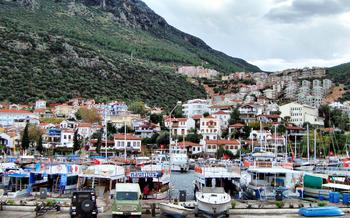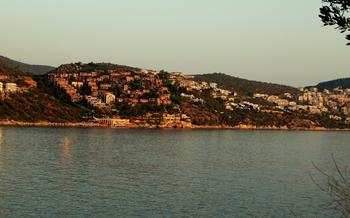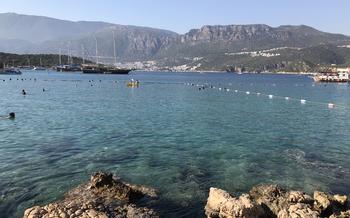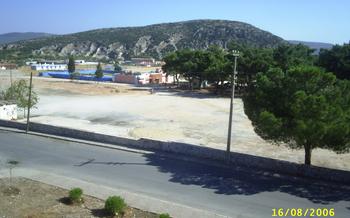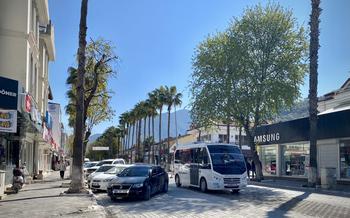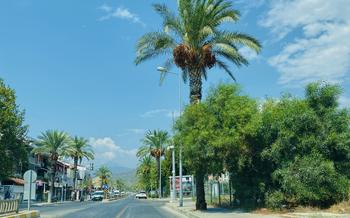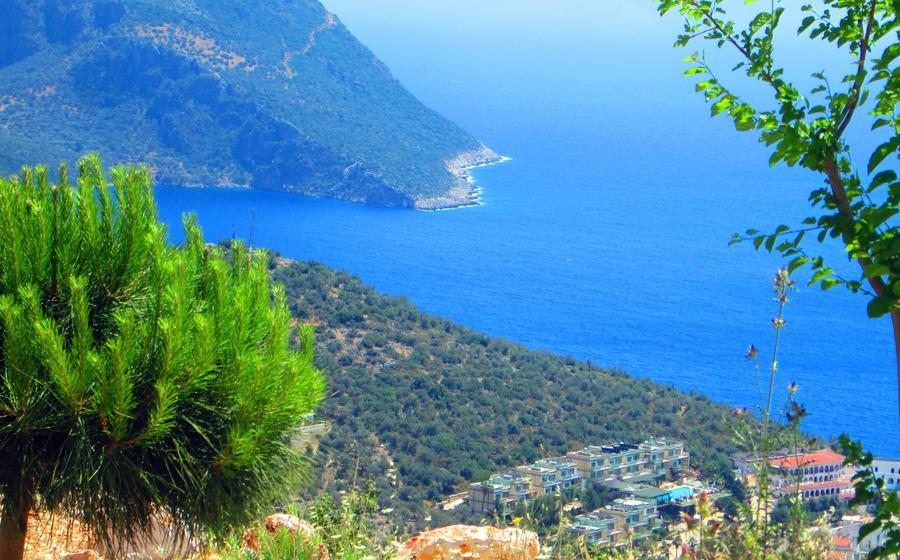
Letoon Ancient City
- Historical Background:
- Archaeological Highlights
- Temple of Leto:
- Bouleuterion
- Agora: The Bustling Marketplace of Letoon
- Theater
- Tombs and Necropolis
- Lycian Way Trail
- Museum of Letoon: A Treasure Trove of Ancient Artifacts
- Natural Beauty
- Local Cuisine
- Accommodation Options
- Getting There
- Best Time to Visit
- Insider Tip:
Historical Background:
In the heart of ancient Lycia, nestled amidst the lush forests and majestic mountains, lies the captivating city of Letoon. This sacred site, once a thriving religious and political center, holds a profound significance in the tapestry of Anatolian history. As a sanctuary dedicated to the goddess Leto and the birthplace of her children, Apollo and Artemis, Letoon played a pivotal role in the spiritual and cultural life of the region. Strategically positioned to control the lucrative trade routes that crisscrossed the Mediterranean, the city flourished, leaving an indelible mark on the history of the ancient world. However, with the waning of the Lycian civilization and the rise of the Byzantine Empire, Letoon's grandeur faded, and it was eventually abandoned to the sands of time, its secrets waiting to be unearthed by future generations.
Archaeological Highlights
The ancient city of Letoon boasts an impressive array of archaeological remains that offer a glimpse into its rich history and significance. Among the most notable highlights is the Temple of Leto, a magnificent structure dedicated to the goddess Leto, mother of Apollo and Artemis. The temple's Doric columns, elaborate pediments, and intricate friezes showcase the architectural prowess of the ancient Lycians. Within the temple, numerous statues and votive offerings have been discovered, attesting to its importance as a sacred site.
Another architectural gem of Letoon is the Bouleuterion, the city's council chamber. This unique structure features a horseshoe-shaped seating arrangement and exceptional acoustics, allowing for effective communication during political debates and decision-making processes. Inscriptions and decrees unearthed within the Bouleuterion provide valuable insights into the city's administration and governance.
The Agora, the bustling marketplace and public gathering place of Letoon, is another significant archaeological site. Here, visitors can explore the remains of shops, warehouses, and public fountains, offering a glimpse into the city's vibrant commercial and social interactions. Ongoing excavations continue to uncover more about the daily life and economic activities that took place in this central hub of Letoon.
The well-preserved theater is a testament to the city's cultural and artistic life. With its impressive size and architectural features, the theater hosted theatrical performances, musical events, and civic assemblies. Discoveries of inscriptions and sculptures related to theater and performance within the theater shed light on the importance of the arts in ancient Letoon.
Beyond the city center, the necropolis outside Letoon offers a glimpse into the funerary practices and beliefs of the ancient Lycians. Various types of tombs and burial structures dot the landscape, providing insights into the social structure and wealth disparities of the city's inhabitants. Grave goods, such as jewelry, pottery, and coins, found within the tombs offer clues about the deceased's status and beliefs about the afterlife.
Temple of Leto:
The Temple of Leto stands as a testament to the religious significance of Letoon. Built in the 4th century BC, this Doric-style temple was dedicated to the goddess Leto, mother of Apollo and Artemis. Its imposing presence dominates the site, with its well-preserved columns, pediments, and friezes narrating the tales of Greek mythology.
The temple's architectural features are a sight to behold. Its Doric columns, adorned with intricate fluting, support a massive entablature decorated with triglyphs and metopes. The pediments, once adorned with sculptures depicting scenes from Greek mythology, still hint at the grandeur of the temple's past.
Within the temple, numerous statues and votive offerings have been discovered, attesting to its importance as a sacred site. These offerings, ranging from small figurines to elaborate reliefs, provide a glimpse into the religious practices and beliefs of the ancient Lycians.
Ongoing restoration efforts aim to preserve and protect this iconic structure, ensuring that future generations can continue to marvel at its architectural splendor and appreciate its significance as a center of religious worship in ancient Letoon.
Bouleuterion
The Bouleuterion, a prominent structure within Letoon, served as the meeting place for the city's council, a body responsible for governing and making decisions on behalf of the community. Constructed with remarkable architectural precision, the Bouleuterion features a distinctive horseshoe-shaped seating arrangement, ensuring that all members had a clear view of the proceedings. Its exceptional acoustics allowed for effective communication and debate among the councilors.
Excavations within the Bouleuterion have yielded a wealth of inscriptions and decrees, providing valuable insights into the administrative and political workings of Letoon. These documents shed light on the city's laws, regulations, and the decision-making processes that shaped its destiny. The Bouleuterion stands as a testament to the democratic principles and civic engagement that characterized ancient Lycian society.
Preservation and restoration efforts are currently underway to safeguard this significant structure. The aim is to protect its architectural integrity and ensure that future generations can continue to appreciate its historical importance. By preserving the Bouleuterion, we honor the legacy of Letoon as a center of governance and decision-making, a place where the voices of its citizens were heard and the foundations of their society were laid.
Agora: The Bustling Marketplace of Letoon
In the heart of the ancient city of Letoon, the Agora served as the bustling marketplace and public gathering place. The Agora was not just a center of trade and commerce but also a place where social interactions, political discussions, and cultural events took place. The archaeological remains of the Agora provide valuable insights into the economic and social dynamics of Letoon.
Excavations have revealed the presence of numerous shops, warehouses, and public fountains within the Agora. These structures attest to the vibrant commercial activities that took place in the city. The Agora was likely the place where local merchants sold their goods, ranging from agricultural produce to imported luxuries. It also served as a hub for trade with neighboring cities and regions, facilitating the exchange of goods and ideas.
Archaeologists have also discovered various artifacts within the Agora, including coins, pottery fragments, and inscriptions. These findings shed light on the economic activities and daily life of Letoon's inhabitants. The inscriptions, in particular, provide valuable information about the city's administration, taxation system, and trade regulations.
Ongoing archaeological investigations in the Agora aim to uncover more about the daily lives of the people who lived in Letoon. By studying the architecture, artifacts, and inscriptions found in this area, researchers hope to gain a deeper understanding of the economic and social organization of the ancient city.
Theater
Letoon's theater is an impressive testament to the city's cultural and artistic achievements. With its well-preserved seating tiers and stage, it could accommodate a large audience and served as a venue for theatrical performances, musical events, and civic assemblies. The theater's size and architectural features, such as its horseshoe-shaped seating arrangement and excellent acoustics, indicate its importance as a center for entertainment and civic life.
The discovery of inscriptions and sculptures related to theater and performance within the theater has shed light on the city's cultural and artistic life. These artifacts provide valuable insights into the types of performances that were held, the actors and musicians who performed, and the role of theater in the community.
Ongoing efforts are being made to restore and maintain this important cultural heritage site. Restoration work aims to preserve the theater's structural integrity and protect its unique features, ensuring that it remains a valuable asset for future generations. Visitors to Letoon can explore the theater, admire its architectural details, and imagine the vibrant atmosphere that once filled this ancient performance space.
Tombs and Necropolis
Outside the bustling city of Letoon, a journey into the past awaits in the sprawling necropolis, a city of the dead that mirrors the grandeur of its living counterpart. Here, amidst the tranquil embrace of nature, lie tombs and burial structures that whisper tales of the ancient Lycians and their reverence for the afterlife.
Explore the diverse array of tombs, each a testament to the Lycians' intricate funerary practices and beliefs. Marvel at the rock-cut chamber tombs, their facades adorned with intricate carvings depicting scenes from mythology and daily life. Discover the imposing temple tombs, their towering structures resembling miniature temples, reserved for the city's elite. And venture into the tumulus tombs, vast mounds of earth concealing burial chambers beneath, where the departed were laid to rest with their most prized possessions.
Excavations within the necropolis have yielded a treasure trove of artifacts that provide glimpses into the Lycians' funerary customs. Discover grave goods such as jewelry, pottery, and coins, speaking of the wealth and status of the deceased. These precious objects accompanied the departed on their journey to the afterlife, ensuring their comfort and prosperity in the realm of the dead.
As you wander through the necropolis, let your mind wander back in time, imagining the solemn processions that once wound their way through these ancient streets, carrying the deceased to their final resting place. Feel the weight of history as you stand before these silent witnesses to a civilization long gone, and contemplate the enduring legacy of the Lycian people.
Lycian Way Trail
The Lycian Way Trail, a long-distance hiking route that traverses the stunning landscapes of Turkey's Turquoise Coast, offers a unique opportunity to combine hiking with cultural exploration. This 509-kilometer trail, which passes through Letoon, is a paradise for hikers and nature enthusiasts, inviting them to immerse themselves in the region's rich history and breathtaking natural beauty.
As you follow the trail, you'll encounter ancient ruins, picturesque villages, and diverse ecosystems, from lush forests to rugged cliffs and sparkling beaches. The Lycian Way offers an unforgettable journey through time and nature, allowing you to discover hidden gems and experience the authentic charm of this enchanting region.
For hikers seeking a more immersive experience, camping along the trail is a fantastic option. Numerous designated campsites provide opportunities to connect with nature, gaze at the starlit sky, and wake up to the sound of birdsong. The Lycian Way Trail is well-marked and maintained, ensuring a safe and enjoyable hiking experience for adventurers of all levels.
Whether you're an experienced hiker or simply seeking an active and rewarding adventure, the Lycian Way Trail is an unmissable experience. Embrace the challenge, immerse yourself in the stunning scenery, and uncover the hidden treasures of ancient Lycia as you journey along this legendary trail.
Museum of Letoon: A Treasure Trove of Ancient Artifacts
The Museum of Letoon is a must-visit attraction for anyone interested in the history and culture of the ancient city. Located in the heart of Kaş, the museum houses a rich collection of artifacts and findings from the archaeological excavations at Letoon.
The exhibits on display provide a comprehensive overview of the city's past, from its religious significance as a sanctuary of the goddess Leto to its role as a political and economic center in Lycia. Visitors can admire impressive sculptures, intricate pottery, and fascinating inscriptions that shed light on the daily life, beliefs, and artistic traditions of the ancient Lycians.
The museum also features a section dedicated to the Lycian Way Trail, a long-distance hiking route that passes through Letoon. Here, hikers can learn about the history and highlights of the trail, as well as plan their own trekking adventure.
With its informative displays and well-curated exhibits, the Museum of Letoon offers visitors a unique opportunity to immerse themselves in the ancient world and gain a deeper understanding of this remarkable archaeological site.
Natural Beauty
Letoon is blessed with an awe-inspiring natural setting, enveloped by lush forests, majestic mountains, and the crystal-clear waters of the Mediterranean Sea. The region boasts a rich biodiversity, with olive groves carpeting the hillsides, verdant pine forests providing shade and tranquility, and a diverse array of bird species filling the air with their melodies.
For nature enthusiasts, Letoon offers a plethora of outdoor activities. Embark on invigorating hikes through the scenic landscapes, immersing yourself in the tranquility of the forests and marveling at the panoramic vistas. Keen birdwatchers can indulge in their passion, spotting a variety of feathered wonders that call this region home. And for those seeking a relaxing day out, idyllic picnic spots await amidst the picturesque surroundings, inviting you to savor delicious local delicacies while basking in the beauty of nature.
Whether you're an avid hiker, a passionate birdwatcher, or simply seeking a peaceful retreat, Letoon's natural splendor promises an unforgettable experience. Embrace the opportunity to explore and appreciate the region's rich biodiversity, leaving you with lasting memories of its breathtaking beauty.
Local Cuisine
The town of Kaş offers a delectable culinary experience, blending Turkish and Mediterranean flavors to create a unique gastronomic tapestry. Fresh seafood is a highlight, with local fishermen bringing in the daily catch of Mediterranean Sea bream, sea bass, and red mullet. Grilled to perfection and seasoned with herbs and olive oil, these dishes are a must-try for seafood lovers.
Grilled meats are another specialty, with succulent lamb chops, kebabs, and köfte (meatballs) tantalizing the taste buds. These dishes are often accompanied by traditional Turkish meze platters, a delightful array of small appetizers that showcase the region's culinary diversity.
For a taste of local delicacies, indulge in piyaz, a white bean salad with tahini dressing, or gözleme, a savory pastry filled with spinach, cheese, or minced meat. Don't miss the Turkish delight, a sweet treat made with sugar, starch, and nuts, often flavored with rosewater or pistachio.
To fully immerse yourself in the local culinary scene, visit the Kaş Pazarı, a vibrant market where you can find fresh produce, spices, and handmade Turkish delights. Cooking classes are also available for those who wish to learn the art of Turkish cuisine and recreate these delicious dishes at home.
Accommodation Options
Kaş offers a diverse range of accommodation options to suit every budget and preference. From budget-friendly guesthouses to luxurious resorts, there's something for every traveler. For a comfortable and convenient stay near Letoon, consider the following recommendations:
-
Hotel Letoon: Located just a short walk from the ancient city, Hotel Letoon offers modern and well-appointed rooms with stunning views of the surrounding mountains and forests.
-
Artemis Hotel: Set amidst lush gardens, Artemis Hotel features spacious rooms with balconies overlooking the Mediterranean Sea. Guests can enjoy a refreshing dip in the outdoor pool or relax in the traditional Turkish bath.
-
Kas Marina Hotel: This upscale hotel is situated in the heart of Kas, offering easy access to the town's vibrant harbor and numerous restaurants and shops. Guests can indulge in a variety of water sports and activities at the hotel's private beach.
For a more budget-conscious option, consider staying at one of the many guesthouses in Kaş. These guesthouses often offer basic but clean and comfortable rooms, as well as a chance to interact with local families and experience Turkish hospitality firsthand.
For those seeking a unique and immersive experience, camping or caravan parks are a great option. These parks offer designated camping spots amidst the stunning natural surroundings of Kaş, allowing you to enjoy the outdoors while still having access to basic amenities.
Remember to book your accommodation in advance, especially during the peak tourist season, to ensure you secure a comfortable and convenient stay.
Getting There
Reaching Kaş and Letoon is a breeze, with multiple transportation options available. If you're flying, the nearest airports are Antalya Airport (AYT) and Dalaman Airport (DLM), both within easy reach of Kaş. From these airports, you can take a direct bus or arrange a private transfer to Kaş, which typically takes around two to three hours.
Alternatively, you can opt for a scenic bus journey from major cities like Istanbul, Ankara, or İzmir. The bus terminals in Kaş are conveniently located, and the journey offers a chance to admire the stunning Turkish landscapes along the way.
For those who prefer the freedom of exploring at their own pace, renting a car is an excellent option. The roads are well-maintained, and the drive from Antalya or Dalaman to Kaş is a pleasant one, offering breathtaking views of the Mediterranean coast.
Once in Kaş, you can easily reach Letoon by taking a short bus ride or hiring a taxi. The journey takes around 15-20 minutes, and the bus stop or taxi stand is conveniently located near the town center.
Here's a pro tip: if you're driving your own car, be sure to take advantage of the stunning coastal road that connects Kaş to Letoon. The drive offers panoramic views of the Mediterranean Sea and is a great way to soak in the beauty of the region.
Best Time to Visit
The best time to visit Letoon and Kaş is during the shoulder seasons, in spring (April-May) and autumn (September-October), when the weather is still pleasant and warm, but the crowds of summer have subsided. During these months, you can enjoy exploring the ancient ruins and natural beauty of the region without having to battle the heat or large groups of tourists.
If you're interested in attending special events and festivals, plan your trip around the Kaş Lycia Festival, which takes place every year in May or June. This festival celebrates the region's rich history and culture with a variety of events, including concerts, exhibitions, and traditional performances.
To make the most of your visit, consider hiring a local guide or booking a tour with a reputable tour operator. These experienced professionals can provide insights into the history and culture of the region and help you discover hidden gems that you might miss on your own.
Insider Tip:
For an unforgettable experience, embark on a guided boat tour from Kaş to the nearby Kekova Island, a hidden gem known for its stunning sunken ruins and crystal-clear waters. Swim and snorkel amidst the ancient Lycian tombs and explore the island's secluded coves and beaches. Don't miss the opportunity to visit the picturesque village of Kaleköy, perched on a rocky peninsula and accessible only by boat. Immerse yourself in the local culture by interacting with the friendly villagers and savoring the delicious seafood delicacies offered at the waterfront restaurants. This unique excursion offers a perfect blend of history, nature, and authentic Turkish hospitality.


